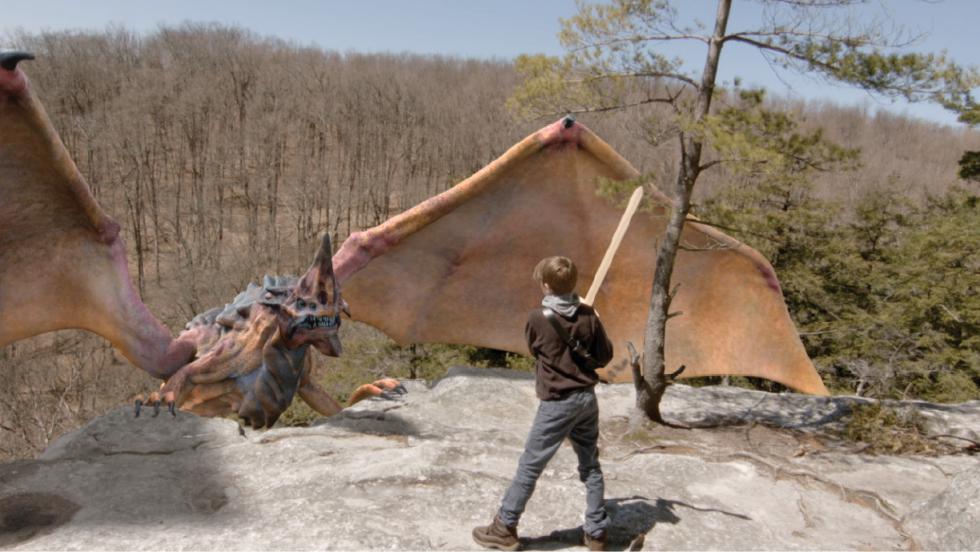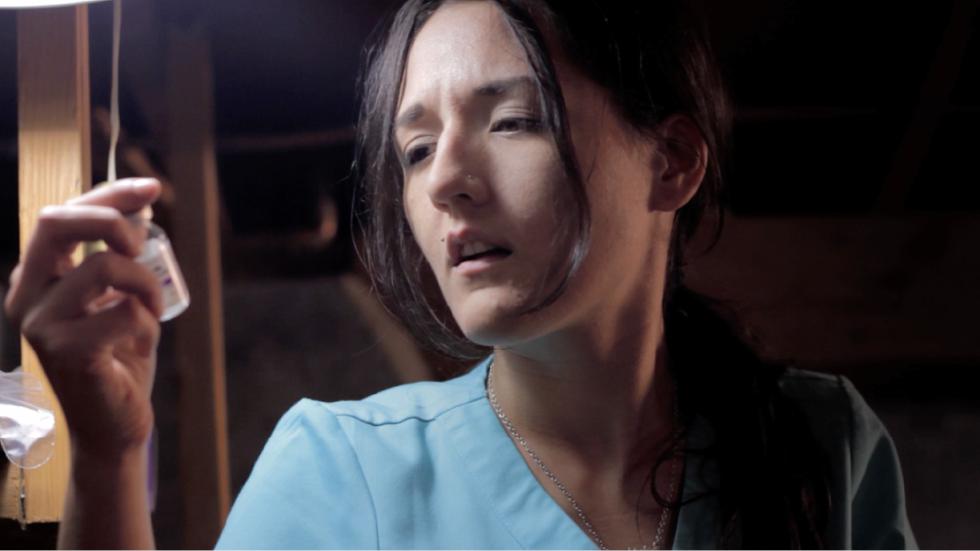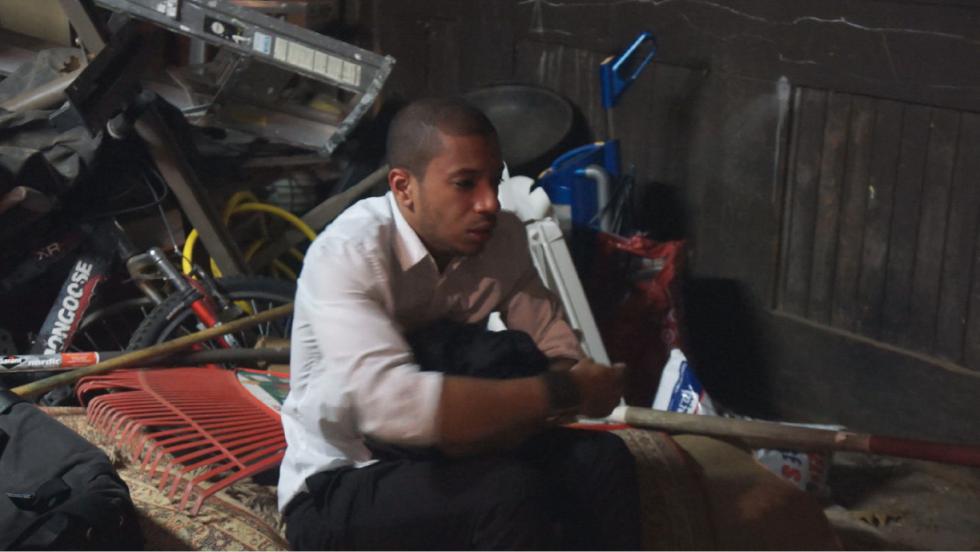When it comes to a homegrown film industry, the Pioneer Valley is hardly Los Angeles, New York, or Boston. But this area is brimming with creative people, and as cameras and film tech become ever more cheap and accessible, young talent is coming up alongside well-established filmmakers.
It’s difficult, often thankless work, and raising funds for new projects is a royal pain. Why keep at it? Artists have an instinctive answer to this age-old question: Because we can’t not do it. As 21-year-old Springfield director V.K. Levigne put it: “For me, it’s film or die.”
We called four local filmmakers this week, each with an exciting new film project in the works or just released, to give us some insight into their art. This is how they roll.
Ben Tobin
Or Else I Shall Be Lost (Short film)
We are all too hasty with our online purchases, so Ben Tobin thought long and hard before buying a dragon.
His new short film Or Else I Shall Be Lost — about a young boy searching the woods for the monster that set fire to his town — needed a convincingly real-looking winged beast. So Tobin, 25, went on a dragon quest of his own. After talking with filmmakers in an online forum on digital effects and connecting with makers of 3D animated models, he settled on a breed he found suitably strange: a horned, muscular thing with six eyes and an orange/pink hide, like an angry cross between a rhino and a rotting peach.
“It’s never going to look as good as Gollum, because that costs millions of dollars,” said the Williamsburg native, who majored in Cinema Studies at Oberlin College. “I didn’t want it to be your typical European-style dragon. I knew that if it looked really familiar, it would register as fake.”
While some film dragons have human traits and personalities, like the charismatic Smaug in the Hobbit movies, Tobin went for something more alien and unsettling. “The movie is about feeling isolated, so that just felt right.”
Or Else I Shall Be Lost, which cost $3,500 to produce, played at the Greenfield Short Film Showcase on Nov. 12 and at the 2014 Ashfield FilmFest, where it won a prize for technical achievement. It is a different kind of project for Tobin, who also makes “slice of life” documentaries about local craftspeople — his half-hour film The Drybrush Master, about Ashfield artist Greg Ruth, just played at San Diego Comic Con, and he is currently finishing a piece on Cummington potter Eric Smith.
But how to describe this spare, wistful film about a boy, a dragon, and the need for revenge?
“I’ve been trying it at children’s festivals,” Tobin explained, adding that Ashfield actor Emmett Ruth was 11 when they shot the film. “It has some experimental elements to it, but it’s not an experimental film. It’s not really fantasy or sci-fi. It’s hard to pin down what genre it is.”
Shot mainly in Ashfield, the film follows the dragon hunter’s quest through forested landscapes, ending on a rocky mountaintop (location: Chapel Ledges on Williamsburg Road). We won’t spoil how the boy’s encounter with the dragon plays out. Suffice it to say that Tobin’s film is just as much an exercise in atmosphere and tone as it is in adventure-making.
For a suspenseful quest story, Or Else I Shall Be Lost is surprisingly elegiac. It looks back. It takes its time. Certain plot details are left ambiguous. Tobin decided to make films after seeing The Lord of the Rings in sixth grade, but it may be that the quiet realism and ruminative characters in his documentaries are leaking into his fiction a bit.
Wherever he goes from here, filmmaking will be central. Tobin is considering the film program at Brooklyn College for next fall. Until then, he’ll continue to devote his spare hours — when he’s not tutoring or working at Amherst Cinema — to freelance filmmaking. “Around here, I feel like all of the elements are in place to make a really cool film industry,” he said. Still, opportunities are limited. “If you’re doing promotional videos around here, which I’ve done, I can’t really ask for my full rate most of the time — it’s not something that many people budget for.”
It may be that Brooklyn, then, is what will take Tobin to the next level.
Ben Tobin’s films can be viewed for free on his Vimeo channel.
Jared Skolnick, Kt Baldassaro
Girl in the Basement (short film)
Streaming online Summer 2016.
Synopsis: A young woman is kidnapped by a serial killer — only on the day of her intended death, fate shifts and the killer accidentally dies, leaving her trapped in his basement.
“The worst thing you could make is something forgettable,” says Jared Skolnick, 28, of Agawam.
Skolnick is a director, but he has day jobs to sustain him until he reaches Spielberg status. He earns a living by doing paid videography and photography for local businesses, as well as freelancing with film crews. In addition to organizing last month’s Greenfield Short Film Showcase — at which his latest film, Girl in the Basement, made its public debut after October completion — he took on four photography jobs in November and one gig working on a commercial.
In a given week, Skolnick says his work-art balance runs 60/40. He spends most of his weekdays doing paid work, but saves about two hours a day for his more artistic endeavors, which he says turn little to no profit. The paid work, which Skolnick does from his home desktop, is “feast or famine.” He’d love to have his own studio when it’s financially feasible, he says, but until then he’s busy paying his dues.
“Everyone has their day jobs,” Skolnick says, adding that taking on gigs in between working on creative projects allows him to mull over artistic details a bit more. “In the long run, I think that gave us more time to think and make [Girl in the Basement] as good as it could be.”
Skolnick — inspired at a young age by the strong stylings of Tim Burton, and later by the big-budget finesse of Peter Jackson on the Lord of the Rings movies — knew he’d be making movies for the rest of his life once he made his first one in high school. The movie, an adaption of The Monkey’s Paw, he did as a senior project at Williston Northampton. He later earned a B.A. in film from Fairfield University in Connecticut.
Skolnick says that for him, making movies is just as much about entertainment and provocation as it is about truth and beauty. He says the most successful movies strike a harmony between those two forces. In making The Earth Rejects Him, for example, Skolnick says he sought to scare the audience, to make them jump, but at the same time to provide a catharsis through the scares.
Skolnick makes movies in the Valley because this is where he’s from and where he began building his professional network. He’s traveled to points west for projects and finds that overall, he can build a reputation just as easily from his home base and he finds an artistic eagerness here he doesn’t see in other places. Also, Girl in the Basement co-director and lead actor Kt Baldassaro (pictured above) points out that living in the Valley while working in the industry means they can be almost equidistant between Boston and Providence and NYC, where a lot of projects take off.
Most often, he’ll collaborate with people in his network on an idea or script before going for it with full force. When choosing whether or not to take on a new project, he says it’s all about the ideas you can’t stop thinking about.
“The main factor in going with an idea is to give it time,” he says. “And if it doesn’t leave your head, it’s the universe telling you to move on it — that means it’s something you can dedicate yourself to.” He says Girl in the Basement was stuck in his head for months before he committed.
Girl in the Basement was born when Kt Baldassaro merged two movies she’d been plotting out into one script. She wanted to explore torture porn put into an intellectual context, and she also wanted to write a script with a female lead who doesn’t realize that what she considers her strength is actually devouring her.
As an actor who enjoys a good horror film, Baldassaro says the script for Girl in the Basement — her first screenwriting and directing experience — stems from a longstanding realization that women in horror films are often sexy or stupid. So this time, she wrote a movie that didn’t allow its heroine to rely on those traits. And then she starred in it and co-directed it.
“The key for women in this industry — in order to get anywhere — is wearing a bunch of different hats in order to get noticed, which is shitty, but look at the stats,” says Baldassaro. “I really want to break through those numbers, get it so people are waiting to see and hear stories from women.”
A recent study by the Center for the Study of Women in Television and Film at San Diego State University reports that seven percent of 2014’s directors were women, and 38 percent of 2014 films had one or no women in behind-the-scenes jobs. By contrast, no films employed one or fewer men, but 69 percent employed 10 to 27 men.
In order for Baldassaro to focus on acting, she teamed up with Skolnick in 2013. The resulting 34-minute film is making its way through the festival circuit.
In the meantime, Skolnick is currently working on pre-production screenwriting for a science fiction film he already knows will be a huge challenge.
“Pre and post-production are very lonely,” he says. “You’re either in front of a notepad or a computer screen. On set, it’s exhilarating — it keeps you sharp.”
V.K. Levigne
Portfolio (A day-in-the-life thriller)
V.K. Levigne’s passion for film was ignited by a VHS tape of Rush Hour 2.
“It was the gag reel,” Levigne says. “It showed me that there were real people doing this.”
It was the first time Levigne had caught any glimpse of the work it takes to make movies. From that point on Levigne, a 21-year-old director and actor with four short films to his credit, sought out deleted scenes, video commentaries — anything that shown a light behind the scenes of the filmmaking process.
“My goal is to help people understand that they can do this here; they can make films here,” Levigne says. “I’m just some guy. I work at the loading dock at Burlington Coat Factory. It’s not only something that only people born into the right societies are capable of.”
Levigne graduated from Holyoke Community College with an associate’s degree in film a few months ago. He lives with family in Springfield and works in the backroom at Burlington in the Holyoke Mall. He’s making films in the Valley on little to no cash. And while Levigne says he would make movies without a penny because he loves the art, going to California where there are more opportunities to work in the film industry is weighing heavily on his mind.
“For me, it’s film or die,” Leveigne says. “I just graduated so it’s either make films for a living or adult-up and get another job. But I couldn’t do anything else except making films.”
Levigne’s most recent work is a short called Portfolio. It’s a film he wrote, directed and starred in. It was shot with a single video camera and a tripod with the help of Levigne’s friend and frequent collaborator, actor Jocelyn Lopez. At 45-minutes, Portfolio is a day-in-the-life story of a young man named Harry whose world is turned upside down. How he deals with this dramatic shift may leave the audience wondering about Harry’s own motives and whether he is innocent amidst the turmoil. “It’s like tunnel-vision,” Levigne says of the movie, which came out in October and can be watched in full on YouTube. “You really get to know the character.”
The style of Levigne’s movies is decidedly gritty. Some of his favorite directors are Christopher Nolan, David Fincher, and Ridley Scott. “I go for realism,” he says.
Now Levigne is fundraising for his next film, Sam, which is about a woman named Sam Morales who seems to have it all. Changing circumstances force Sam to take a job in the most dangerous part of town, which is when the mystery surrounding this action movie emerges. The script is set, the cast is picked, but Levigne says production needs $3,000, mostly for additional equipment. A Kickstarter has been set up for Sam, though at the time of the interview, zero donations had been made. The drive closes Dec. 25. “I’m very aware we have no donations,” Levigne says shaking his head. “But I’ll make this movie even without the funding.” Levigne wrote this film for Lopez to star in and he can’t imagine anyone else filling the role.
As much as Levigne loves the area, if funding for Sam doesn’t go well, he’s almost sure to head out to California this winter to start a career there working in the industry he loves, to make the films he needs to.
But that doesn’t mean the Valley will be without Levigne’s creativity.
“Whatever I do, whenever I do it, I’ll always be sending my work back to the Valley,” he says, “so others can see it and get inspired by it. Who knows? Maybe some day some kid will be watching a VHS of my movie and will get inspired to make something great.” •
Larry Hott
Sci-Tech Band: Pride of Springfield (Documentary)
Dozens of students at Springfield High School of Science and Technology lift their instruments and play a single musical note, all together, for the first time in their lives. What comes out is not pretty, to say the least. It sounds, in the words of one student, “like an animal dying.”
But this is only the first day of rehearsal for Sci-Tech Band. In three months, under the enthusiastic direction of band leader Gary Bernice, all of these flutes, guitars, trombones and trumpets will close out the fall semester by playing the annual Winterfest concert for family and friends. And they won’t sound half bad.
By now, stories of how innovative arts programming can keep kids in school, boost graduation rates, and help them succeed further down the road are time-tested and proven as reliable, inspirational lessons. The 2005 documentary Mad Hot Ballroom tracked 10 and 11-year-olds through a dance competition in New York City, and 2012’s Brooklyn Castle examined a high school championship chess team that beat the odds.
“This is not the most original idea,” said Larry Hott, 65, of Florentine Films/Hott Productions in Northampton. “I knew that going in. But I had to do it because it’s happening right here in Springfield. And I knew that music people around the country would pick up on it.”
After seeing the band perform live a few times, Hott lined up a series of visits to the school, working with a nonprofit called Springfield School Volunteers as a fiscal sponsor.
Hott spent several weeks of the fall semester of 2014 in rehearsal with Bernice and the students (the high school has about 1,500 students, and a staggering 500 of them are in the Sci-Tech Band).
The finished half-hour film, called Sci-Tech Band: Pride of Springfield, premiered in May. It is uplifting, funny, and entertaining. As a piece of documentary filmmaking, it is fairly simple and straightforward, which is just what Hott was going for.
“I had decided before I even had the subject matter that I wanted to find a film I could do in my backyard that would have some meaning,” said Hott, who has been making documentaries since 1978, many of them for national PBS broadcast.
He describes the budget for the Sci-Tech film as a “miniscule” $69,000 — less than one-tenth the budget of his last project, which documented recent attempts to salvage the language of the Lakota people in Great Plains Native American communities.
Hott was not paid for the Sci-Tech project, and the film is distributed for free on YouTube.
“In the abstract, you can say that since these kids come from poor backgrounds and problem families, they can’t blossom in these circumstances,” Hott said. “But then you get in there and you meet them. They’re so smart and enthusiastic. You talk to them, and you see how much they want to make it, and how much they care for each other.
“That’s what makes the band work,” he added. “Why do they stay in school? Is it for the love of music? Maybe for some. But they love the group. One girl says: ‘We’re family.’ You really can see that.”
Even though the Sci-Tech project wrapped in the spring, the story is still very much on Hott’s mind. On June 1, five days after the high school threw a red-carpet premiere party for the film, Hott packed his bags and flew to Vietnam for a month to teach film techniques to Vietnamese journalists, a trip paid for through a Fulbright grant.
He screened clips of several film clips, but Sci-Tech Band: Pride of Springfield he screened in its entirety.
“I was pleased to see that this was a universal story,” he said. “In a culture that is so different in many ways, they not only understood the story — they could get it without any subtitles — they embraced it. That’s why I showed it. It is an example of a film that anyone can do.”






